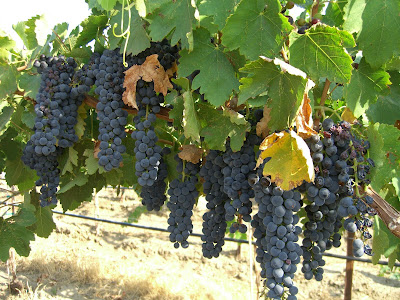
It has been a long time since my last post. Lots of life has happened, but nothing that seemed worthy of subjecting other people to. This summer been an unbelieveably fun episode of mostly hanging out, some traveling, a quick 35 day voyage around the Pacific, and a bit of tending to a small vineyard in the Red Mountain AVA in eastern WA. As far as vineyards go, its been a bad year. We decided we were in over our heads and ripped out a large portion of it. Now we have only a small fraction left, and its scenic and fun and definately not as back-breaking. Maybe someday a billionaire will buy it from us and put in a McMansion winery. If you know of anyone who might be interested, let them know. Yesterday, the weeds and bulldozers were put aside and Christophe and I hauled our buckets down each row to harvest what grapes we could. It was in the mid 80s and a perfect day to pick. Only a few of our plants are bearing fruit this year and we had about 150 lbs of total crop. Harvest is my favorite job during the year of a vineyard's life. Some of the clusters of grapes were dried up raisins, hard as pebbles for some reason, and others had been picked over by the birds. The majority of the clusters however were tight, and full and beautiful. Even with all the mistakes we had made piled on top of each other somehow mother nature prevailed in the end and produced a few thousand perfect berries. There is something about finding a perfect cluster of plump grapes hidden in the lush green vine that feels like finding a bunch of jewels after a long dramatic adventure. Romantic poems come to mind, and the work is pleasing. Classical music trills in your head, even amongst the reports of nearby propane bird guns, and there is an excitement to see what the next plant will yield.

Christophe and I hauled our 25 gallons of grapes to his sister's small winery in the basement where I painstakingly pulled each berry off the stem for a while before losing patience with that process and deciding to stomp them while in the bucket and then pull the loose stems out. We ended up with 12.7 gallons of deeply red must. With Brent's help we added a sulfite mixture that prevents oxidation and retards the growth of the natural yeasts found on the grape skins and in the air. We mixed the sulfur in well and left the must in the fermenter overnight. Our batch of must is about 30% whole berries and 70% crushed. This ratio affects the "fullness" of the wine. 100% whole berry fermentation is common in Beaujolais, and results in a lighter, fruiter wine, whereas crushed berry fermentation results in more of the compounds found in the grape skin entering the wine, tannins, the mythical Reversatrol, and who knows what else. While involved in detail oriented hand destemming I had the sense that I was capturing an entire ecosystem, not just one fruit. When crushing the grapes, everything that lives IN the cluster of grapes goes into the must as well. This idea was a little unpallatable at first, the idea that a nice bottle of wine might acuatlly contain 0.2% crushed spider and spider nests, but after digesting this revelation it merely adds to the mystery of how a bottle of wine, somehow becomes more than just a bottle of wine. Maybe it is those unmentionables and the entirety of a small world that gets captured which helps to produce something more than the sum of its parts.
No comments:
Post a Comment